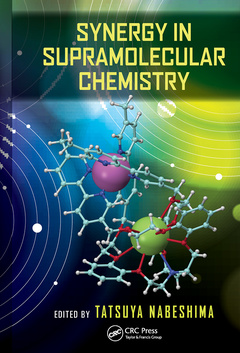Description
Synergy in Supramolecular Chemistry
Coordinator: Nabeshima Tatsuya
Language: English
Subjects for Synergy in Supramolecular Chemistry:
Keywords
LCST Behavior; NMR Timescale; Supramolecular Chemistry; American Chemical Society; Molecular Function; Receptor Anion Complexes; Nano science; Alkoxy Chain Length; Multi-metal Supramolecular Systems; Dynamic Covalent Chemistry; Supramolecular Architectures; Molecular Capsules; LCST Polymer; NMR Spectroscopy; Phenylboronic Acid; Supramolecular Catalysts; Guest Molecules; Boronic Acid; Phenylboronic Acid Moiety; Ion Pair; Imine Bond Formation; Host Guest Interaction; NMR Spectrum; SULFENIC Acid; Supramolecular Polymers; Synchrotron XRD Pattern; Pom Texture; Vis Spectroscopy; Thermosensitive Polymers; TK
Publication date: 12-2021
· 15.6x23.4 cm · Paperback
Publication date: 12-2014
349 p. · 15.6x23.4 cm · Hardback
Description
/li>Contents
/li>Biography
/li>
Cooperative and synergistic chemical events have attracted significant attention from many researchers engaged in organic chemistry, inorganic chemistry, biological chemistry, polymer chemistry, medicinal chemistry, and other related materials sciences. Synergistic supramolecular systems could be developed to amplify the functions and integration of molecular devices in ways that cannot be achieved by conventional single molecules. This book introduces basic concepts and examples of supramolecular chemistry in terms of cooperation and synergy, and it surveys recent progress in this field.
Synergy and Cooperativity in Multi-metal Supramolecular Systems. Hierarchically Assembled Titanium Helicates. Supramolecular Hosts and Catalysts Formed by Self-assembly of Multinuclear Zinc Complexes in Aqueous Solution. Supramolecular Assemblies Based on Interionic Interactions. Supramolecular Synergy in the Formation and Function of Guanosine Quadruplexes. On-Surface Chirality in Porous Self-Assembled Monolayers at Liquid-Solid Interface. Polymeric Architectures Formed by Supramolecular Interactions. Synergy in Self-Assembled Molecular Capsules. Synergistic Effects in Foldamer Design and Properties. Salt Templated Syntheses of Interlocked Molecules. Stabilization of Reactive Species in Supramolecular Architectures. Supramolecular Catalyst Based on Cyclodextrin Derivatives. Supramolecular Function of Cyclodextrin Complex Sensors for Ion and Molecule Recognition in Water. Cooperativity in Complexation of Dynamic Terephthalamide Hosts for the Design of Chirality-Sensing Systems. Lanthanides Driven Self-Assembly Formation of Luminescent Supramolecular Structures. Supramolecular Chemistry Strategies for Naked-Eye Detection and Sensing. Synergisms in Lanthanide-Based Supramolecular Luminescent Assays and Sensors. Chemo-Sensitive Soft Matters. From Fundamental Aspects of Binding Properties in Host–Guest Complexations to Those beyond the Limitation Due to the Law of Mass Action.
Tatsuya Nabeshima was born in 1955 in Kumamoto, Japan. He received his B.S. (1979) from The University of Tokyo, M.S. (1981) from the University of Tsukuba, and Ph. D. degrees (1985) from Kyoto University. In 1985, he joined Stanford University as a postdoctoral fellow. After joining the University of Tsukuba as a research associate in 1986, he became Assistant Professor in 1987. He moved to Gunma University as an assistant professor in 1989 and was promoted to Associate Professor in 1991. He returned to the University of Tsukuba as an associate professor in 1995, and was promoted to Professor in 1999. In 2004 he was a Professor of the Graduate School of Pure and Applied Sciences, University of Tsukuba, and from 2010 to 2012 he was Director of Tsukuba Research Center for Interdisciplinary Materials Science (TIMS), University of Tsukuba. His research interests cover artificial receptors, molecular recognition, artificial allosteric and responding molecular systems, and organic-inorganic supramolecular systems. He received The Chemical Society of Japan Award for Creative Work in 2008.
These books may interest you

Supramolecular Polymers 74.82 €



